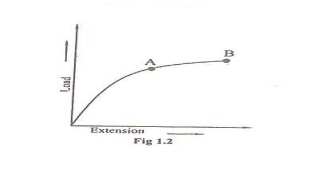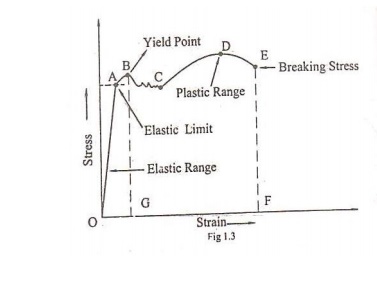Chapter: Physics : Properties of Mater and Thermal Physics
Hooke's Law
HOOKE’S LAW
It
is found the stress and strain always accompany each other, without stress,
strain will not be there and vice versa.
Robert Hooke, proposed a relation
between stress and strain and I s named as Hooke’s law by his name.
Statement:
according to this law, “Stress is directly proportional to the strain produced,
within the elastic limit”
Stress ∞ strain
Stress=E*strain
E=Stress\Strain Nm-2
Where E is called as modulus of the
elasticity.The value of E depends upon the nature of the material.
1 ELASTIC LILIT
When the forces are applied
to the bodies, each and every body has a tendency to oppose the force and will
try to regain its original position after the removal of the force. When the
applied force is increased beyond the maximum value, the body does not regain
its original position completely, even after the removal of the external force.
Hence the maximum stress up to which a body can recover its original shape and
size, after removing the external forces is called Elastic limit.
2
YIELD
POINT
Let us consider a wire loaded by some
forces. It obeys Hooke’s law and the wire extends up to a limit called elastic
limit (A) as shown in the figure. If the load is applied beyond the elastic
limit, Hooke’s law is no longer obeyed and the extension increases to the point
‘B’ even for a small increase in the load. Now, even if the load is removed the
wire will not regain its original position. Therefore, the point at which the
body loses its elasticity is called Yield Point represented by ‘B’

3 ELASTIC FATIGUE
If a body continuously subjected
to Stress or Strain, it gets fatigued (weak), called Elastic Fatigue.
Example:
Consider two torsional pendulums A and B of same wires. Let the pendulum ‘A’ be
set into oscillation continuously. After some time if ‘A’ comes to rest, make
both pendulums ‘A’ and ‘B’ to oscillate simultaneously. It is found that
pendulum ‘A’ comes to earlier than pendulum ‘B’ due to elastic fatigue.
4 STRESS-STRAIN DIAGRAM
Let
us consider a body which is subjected to a uniformly increasing stress. Due to
the application of stress, the change in dimension of the body takes place i.e
the strain is developed. If we plot a graph between stress and strain we get a
curve as shown in the figure and called STRESS-STRAIN
diagram.
1.
From figure, it is
found that the body obeys Hooke’s law upon the region OA called as elastic
range.
2.
As soon as the maximum
elastic limits i.e Yield point ‘B’ is crossed, the strain increases rapidly
than the stress.
3.
At this stage the body
remains partly elastic and partly plastic which is represented by the curve.

4.
Now, even if a small
external force is applied, the body will take a new path CD and remains as
plastic range, where D is called ultimate strength.
5.
After this, the body
will not come to its original state and the body acquires a permanent residual
strain and it breaks down at a point called a breaking stress indicated by
dotted line EF.
Related Topics